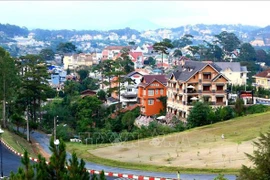Associate Professor Pham Thuy Loan, a representative from the Asian IndustrialHeritage Conservation Network in Vietnam, said that the country had industrialbuildings with heritage value, but no industrial heritage.
The concept of industrial heritage has yet to be legalised or included in legaldocuments, making it impossible to protect those heritages.
She said that was the biggest barrier to protecting industrial heritage inVietnam.
Cultural industry development is a new issue, and Hanoi does not have muchexperience promoting its potential advantages.
Pham Thi Lan Anh, head of the Heritage Management Division under the HanoiDepartment of Culture and Sports, said that the city authorities paid muchinterest and hoped that industrial heritage would become a part of the capitalcity's urban and cultural heritage.
Many countries recognise industrial heritage as a part of their cultural andsocial history.
Alban Corbier-Labasse, director of the Friche la Belle de Mai Cultural Complexin Marseille, France, said the complex was successful thanks to the combinationof two wills. One is the government's will, and the other is the people'sinitiative.
He said that optimal use of existing and reserving spaces for future creativepurposes was essential.
Therefore, together with leisure activities, the complex is becoming anattractive address for local people and many tourists.
The Utrecht Community (Uco) workspace is another example.
Converted from a dilapidated train depot of the Dutch Railways, the Uco hasprovided 1,800sq.m for work, meetings and performances.
The Uco building was designed and followed standards throughout its renovation.
Uco considered every detail to find sustainable solutions during its renovationand furnishing.
The design brings fresh air and uses non-toxic materials and natural light.
That's why this space has worked effectively over the years by reusing anindustrial heritage combined with energy-efficient sustainable design.
In July this year, the Hanoi People's Council passed a resolution with a listof buildings that must be relocated. Of these, nine industrial buildings mustbe relocated within five years.
The resolution included a method of relocation and conversion of thesebuildings and a plan for management and taking-over vacant land afterrelocation.
But the plan caused many challenges for the city when there were no policies,regulations, methods of industrial heritage appraisal and no successful modelof heritage reconstruction.
Architect Phan Dang Son, chairman of the Vietnam Association of Architects,said that it would be a pity if the nine buildings were transferred to urbanareas with economic value only.
It they was rebuilding towards industrial heritage, it would open up manyopportunities for Hanoi to develop into a creative city.
Architect Pham Trung Hieu, lecturer at the Hanoi University of Architecture,who gave proposals to convert the Gia Lam Train Factory, said that therelocation of nine old factories would open a huge land bank for the city.
This is an opportunity for Hanoi to have enough space to transform and become adynamic creative city.
Hieu suggested that the creative cultural space converted from those locationsensure three components; adaptive conservation of valuable heritage, creativecommunity space, and space for green trees.
All should be linked into a lively landscape system.
Many other architects agreed that rebuilding old factories needed to besuitable with the surrounding background, ensuring economic values, preservingculture and minimising environmental impacts.
Those buildings should include creative spaces for exhibitions, seminars, andplaces to nurture start-ups.
The city and residents will enjoy not only culture but also a place to promotecreative economic activities./.





























